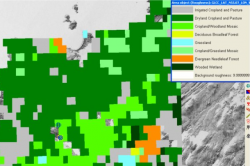Global Land Cover Characteristics: Difference between revisions
| Line 10: | Line 10: | ||
<center> | <center> | ||
{| class="wikitable" | {| class="wikitable" | ||
|+ align="bottom"|Table: | |+ align="bottom"|Table: USGS Legend for the GLCC Data with Roughness Classification Data by EMD | ||
! | !ID | ||
! | !Land Cover Type | ||
!EMD Roughness Class | |||
!Roughness Class | |||
|- | |- | ||
| | |1 | ||
| | |Urban and Built-Up Land | ||
|0.0005 m | |0.0005 m | ||
|0. | |z0=0.400 | ||
|} | |} | ||
Revision as of 16:41, 25 May 2013
Introduction

Initially, the Global Land Cover Classification (GLCC) dataset was developed for land cover characterization in the range of environmental research and modelling applications. It is derived from the Advanced Very High Resolution Radiometer (AVHRR) data spanning a 12 month period from April 1992 to March 1993. The ACHHR is a space-borne sensor mounted on the National Oceanic and Atmospheric Administration (NOAA) family of polar orbiting platforms.
Coverage
This dataset has a global coverage. It is based on a 1 km x 1 km grid, so note that such a resolution is to coarse for Micro scale AEP calculation models! This data is the version 2.0 of the global land cover characteristics data base, see the USGS web site [1].
Legends
Various legends exist for this dataset. At EMD, we use the legend from the US Geological Survey, see the table below. In addition to the legend, we (EMD) also suggested a roughness length. This length is shown in parenthesis in the table.
| ID | Land Cover Type | EMD Roughness Class | |
|---|---|---|---|
| 1 | Urban and Built-Up Land | 0.0005 m | z0=0.400 |
External Link
Global Land Cover Characteristics Data Base Version 2.0, available at: http://edc2.usgs.gov/glcc/glcc.php (2013).